Culture & Perceptions: An Analysis of Intercultural Relations
VerifiedAdded on 2023/05/31
|10
|2867
|341
Essay
AI Summary
This essay explores the profound influence of culture on individual perceptions within intercultural relations, examining how cultural backgrounds shape viewpoints and create potential communication barriers. It delves into the role of language and non-verbal cues as integral components of culture, highlighting their impact on effective communication across diverse groups. The essay further addresses challenges arising from cultural values, particularly concerning gender roles and the integration of women in the workplace, as well as issues encountered during intercultural interactions due to migration. The importance of cultural identity is emphasized, alongside the role of intercultural communication in fostering innovation and sustainability within international business. A reflective section discusses how the course of study has shifted the author's assumptions and viewpoints regarding intercultural communication, enhancing their understanding of its complexities and benefits.
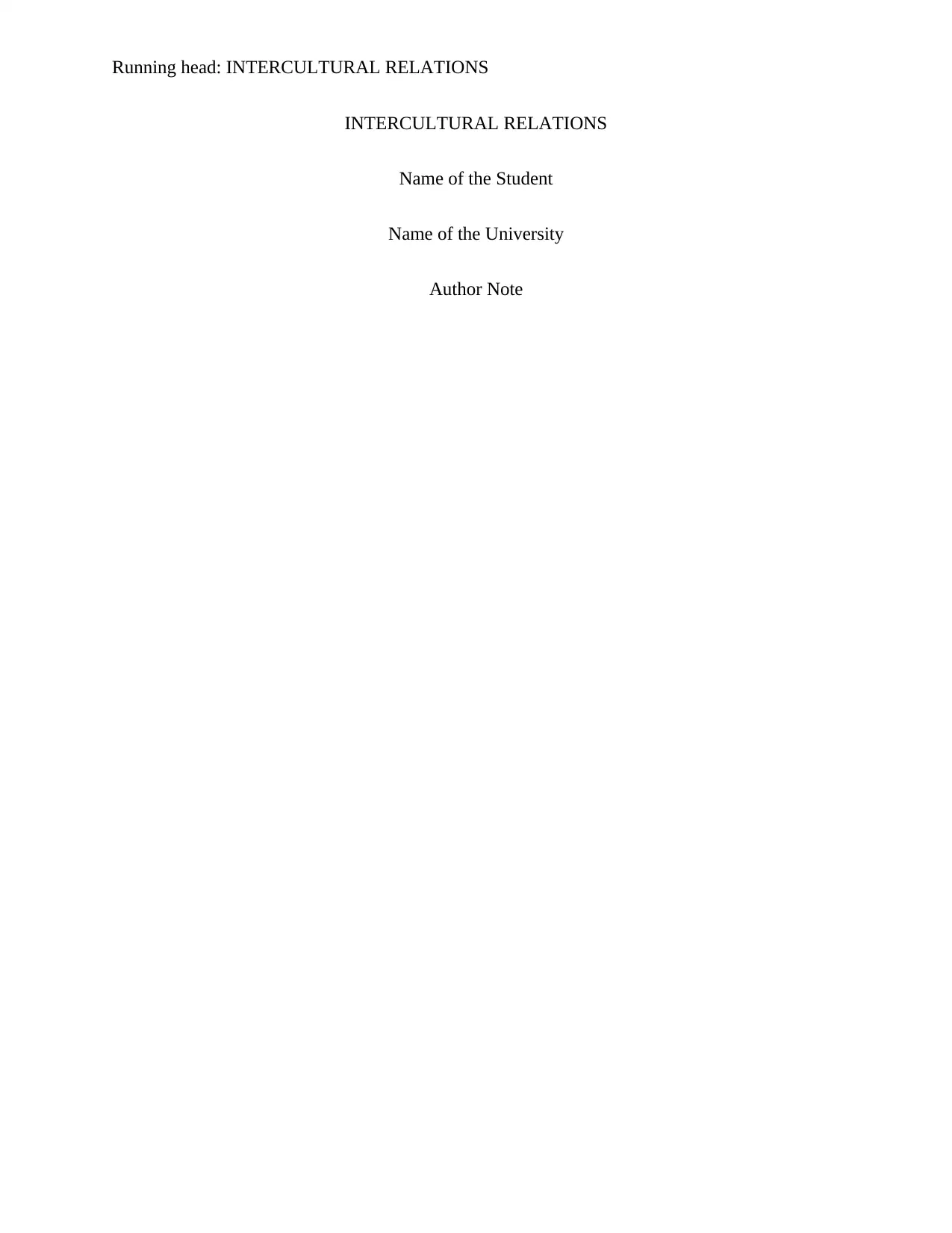
Running head: INTERCULTURAL RELATIONS
INTERCULTURAL RELATIONS
Name of the Student
Name of the University
Author Note
INTERCULTURAL RELATIONS
Name of the Student
Name of the University
Author Note
Paraphrase This Document
Need a fresh take? Get an instant paraphrase of this document with our AI Paraphraser
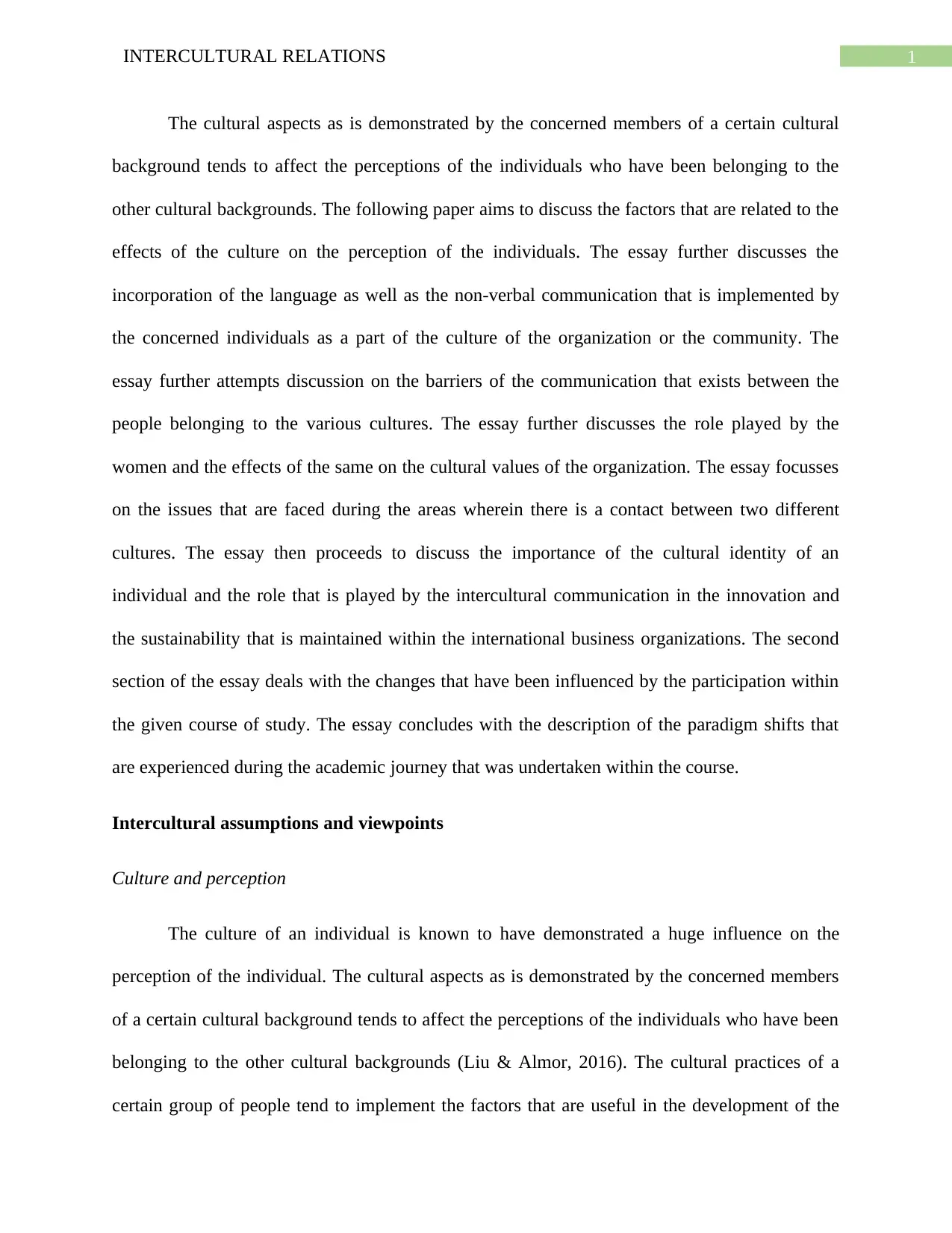
1INTERCULTURAL RELATIONS
The cultural aspects as is demonstrated by the concerned members of a certain cultural
background tends to affect the perceptions of the individuals who have been belonging to the
other cultural backgrounds. The following paper aims to discuss the factors that are related to the
effects of the culture on the perception of the individuals. The essay further discusses the
incorporation of the language as well as the non-verbal communication that is implemented by
the concerned individuals as a part of the culture of the organization or the community. The
essay further attempts discussion on the barriers of the communication that exists between the
people belonging to the various cultures. The essay further discusses the role played by the
women and the effects of the same on the cultural values of the organization. The essay focusses
on the issues that are faced during the areas wherein there is a contact between two different
cultures. The essay then proceeds to discuss the importance of the cultural identity of an
individual and the role that is played by the intercultural communication in the innovation and
the sustainability that is maintained within the international business organizations. The second
section of the essay deals with the changes that have been influenced by the participation within
the given course of study. The essay concludes with the description of the paradigm shifts that
are experienced during the academic journey that was undertaken within the course.
Intercultural assumptions and viewpoints
Culture and perception
The culture of an individual is known to have demonstrated a huge influence on the
perception of the individual. The cultural aspects as is demonstrated by the concerned members
of a certain cultural background tends to affect the perceptions of the individuals who have been
belonging to the other cultural backgrounds (Liu & Almor, 2016). The cultural practices of a
certain group of people tend to implement the factors that are useful in the development of the
The cultural aspects as is demonstrated by the concerned members of a certain cultural
background tends to affect the perceptions of the individuals who have been belonging to the
other cultural backgrounds. The following paper aims to discuss the factors that are related to the
effects of the culture on the perception of the individuals. The essay further discusses the
incorporation of the language as well as the non-verbal communication that is implemented by
the concerned individuals as a part of the culture of the organization or the community. The
essay further attempts discussion on the barriers of the communication that exists between the
people belonging to the various cultures. The essay further discusses the role played by the
women and the effects of the same on the cultural values of the organization. The essay focusses
on the issues that are faced during the areas wherein there is a contact between two different
cultures. The essay then proceeds to discuss the importance of the cultural identity of an
individual and the role that is played by the intercultural communication in the innovation and
the sustainability that is maintained within the international business organizations. The second
section of the essay deals with the changes that have been influenced by the participation within
the given course of study. The essay concludes with the description of the paradigm shifts that
are experienced during the academic journey that was undertaken within the course.
Intercultural assumptions and viewpoints
Culture and perception
The culture of an individual is known to have demonstrated a huge influence on the
perception of the individual. The cultural aspects as is demonstrated by the concerned members
of a certain cultural background tends to affect the perceptions of the individuals who have been
belonging to the other cultural backgrounds (Liu & Almor, 2016). The cultural practices of a
certain group of people tend to implement the factors that are useful in the development of the
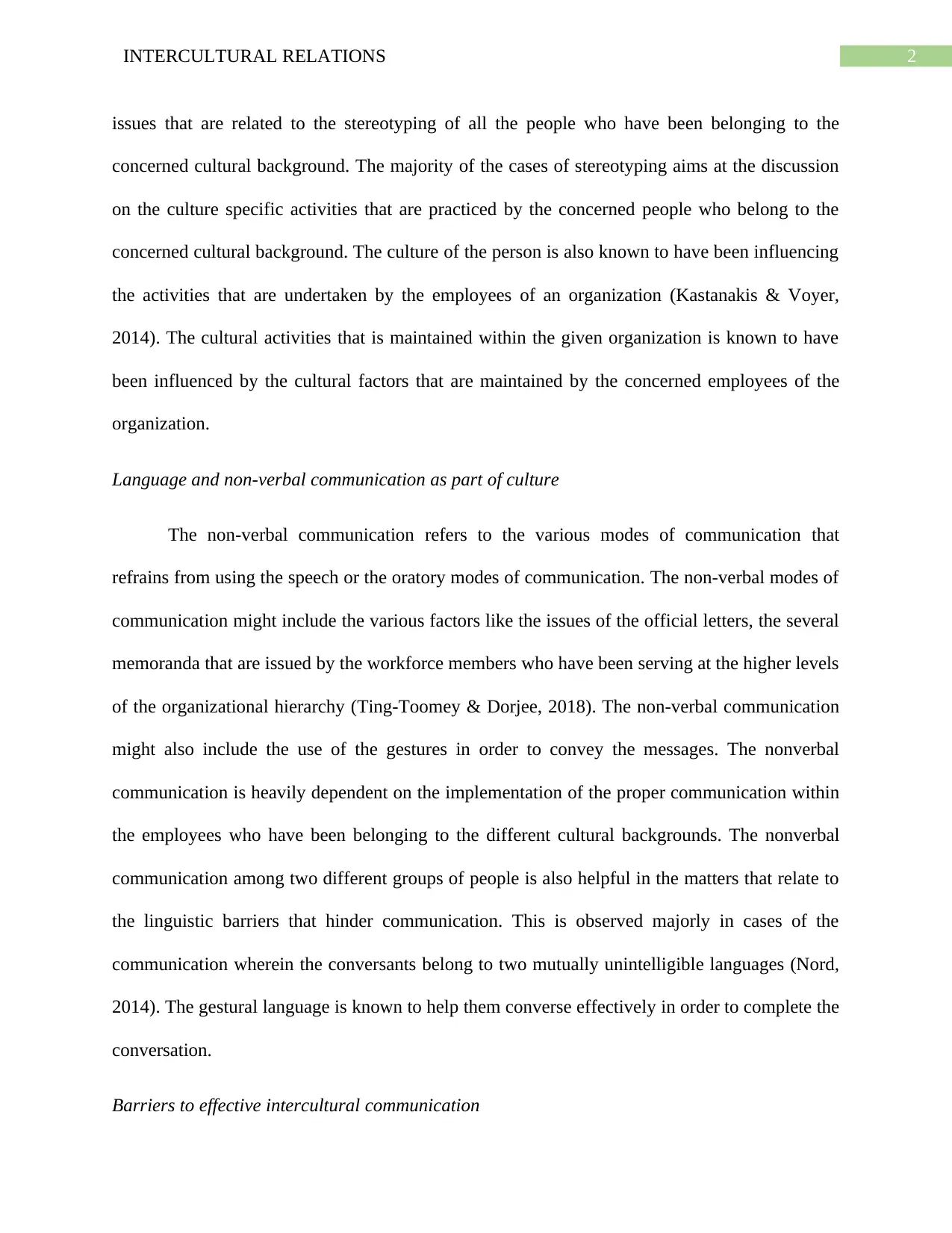
2INTERCULTURAL RELATIONS
issues that are related to the stereotyping of all the people who have been belonging to the
concerned cultural background. The majority of the cases of stereotyping aims at the discussion
on the culture specific activities that are practiced by the concerned people who belong to the
concerned cultural background. The culture of the person is also known to have been influencing
the activities that are undertaken by the employees of an organization (Kastanakis & Voyer,
2014). The cultural activities that is maintained within the given organization is known to have
been influenced by the cultural factors that are maintained by the concerned employees of the
organization.
Language and non-verbal communication as part of culture
The non-verbal communication refers to the various modes of communication that
refrains from using the speech or the oratory modes of communication. The non-verbal modes of
communication might include the various factors like the issues of the official letters, the several
memoranda that are issued by the workforce members who have been serving at the higher levels
of the organizational hierarchy (Ting-Toomey & Dorjee, 2018). The non-verbal communication
might also include the use of the gestures in order to convey the messages. The nonverbal
communication is heavily dependent on the implementation of the proper communication within
the employees who have been belonging to the different cultural backgrounds. The nonverbal
communication among two different groups of people is also helpful in the matters that relate to
the linguistic barriers that hinder communication. This is observed majorly in cases of the
communication wherein the conversants belong to two mutually unintelligible languages (Nord,
2014). The gestural language is known to help them converse effectively in order to complete the
conversation.
Barriers to effective intercultural communication
issues that are related to the stereotyping of all the people who have been belonging to the
concerned cultural background. The majority of the cases of stereotyping aims at the discussion
on the culture specific activities that are practiced by the concerned people who belong to the
concerned cultural background. The culture of the person is also known to have been influencing
the activities that are undertaken by the employees of an organization (Kastanakis & Voyer,
2014). The cultural activities that is maintained within the given organization is known to have
been influenced by the cultural factors that are maintained by the concerned employees of the
organization.
Language and non-verbal communication as part of culture
The non-verbal communication refers to the various modes of communication that
refrains from using the speech or the oratory modes of communication. The non-verbal modes of
communication might include the various factors like the issues of the official letters, the several
memoranda that are issued by the workforce members who have been serving at the higher levels
of the organizational hierarchy (Ting-Toomey & Dorjee, 2018). The non-verbal communication
might also include the use of the gestures in order to convey the messages. The nonverbal
communication is heavily dependent on the implementation of the proper communication within
the employees who have been belonging to the different cultural backgrounds. The nonverbal
communication among two different groups of people is also helpful in the matters that relate to
the linguistic barriers that hinder communication. This is observed majorly in cases of the
communication wherein the conversants belong to two mutually unintelligible languages (Nord,
2014). The gestural language is known to help them converse effectively in order to complete the
conversation.
Barriers to effective intercultural communication
⊘ This is a preview!⊘
Do you want full access?
Subscribe today to unlock all pages.

Trusted by 1+ million students worldwide
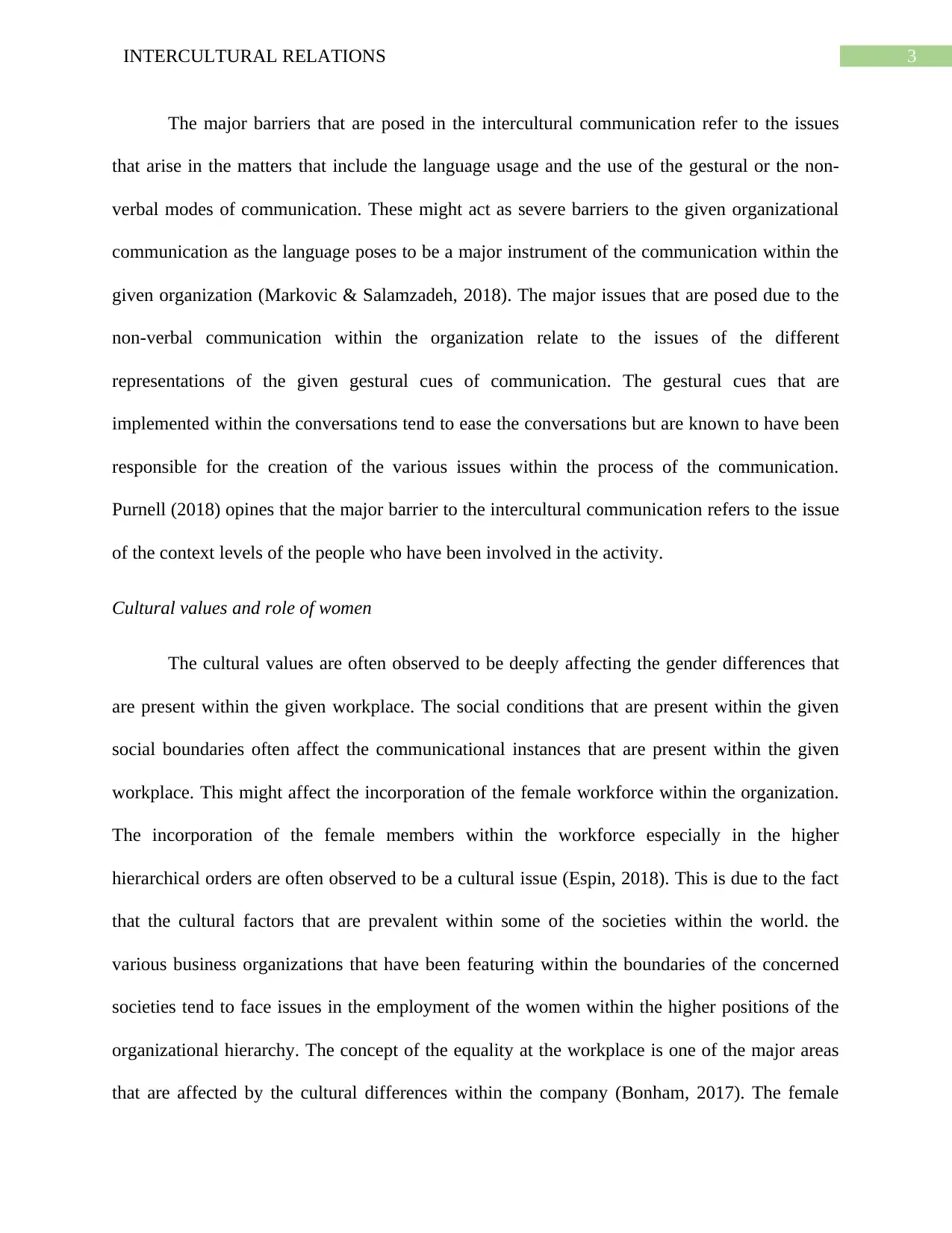
3INTERCULTURAL RELATIONS
The major barriers that are posed in the intercultural communication refer to the issues
that arise in the matters that include the language usage and the use of the gestural or the non-
verbal modes of communication. These might act as severe barriers to the given organizational
communication as the language poses to be a major instrument of the communication within the
given organization (Markovic & Salamzadeh, 2018). The major issues that are posed due to the
non-verbal communication within the organization relate to the issues of the different
representations of the given gestural cues of communication. The gestural cues that are
implemented within the conversations tend to ease the conversations but are known to have been
responsible for the creation of the various issues within the process of the communication.
Purnell (2018) opines that the major barrier to the intercultural communication refers to the issue
of the context levels of the people who have been involved in the activity.
Cultural values and role of women
The cultural values are often observed to be deeply affecting the gender differences that
are present within the given workplace. The social conditions that are present within the given
social boundaries often affect the communicational instances that are present within the given
workplace. This might affect the incorporation of the female workforce within the organization.
The incorporation of the female members within the workforce especially in the higher
hierarchical orders are often observed to be a cultural issue (Espin, 2018). This is due to the fact
that the cultural factors that are prevalent within some of the societies within the world. the
various business organizations that have been featuring within the boundaries of the concerned
societies tend to face issues in the employment of the women within the higher positions of the
organizational hierarchy. The concept of the equality at the workplace is one of the major areas
that are affected by the cultural differences within the company (Bonham, 2017). The female
The major barriers that are posed in the intercultural communication refer to the issues
that arise in the matters that include the language usage and the use of the gestural or the non-
verbal modes of communication. These might act as severe barriers to the given organizational
communication as the language poses to be a major instrument of the communication within the
given organization (Markovic & Salamzadeh, 2018). The major issues that are posed due to the
non-verbal communication within the organization relate to the issues of the different
representations of the given gestural cues of communication. The gestural cues that are
implemented within the conversations tend to ease the conversations but are known to have been
responsible for the creation of the various issues within the process of the communication.
Purnell (2018) opines that the major barrier to the intercultural communication refers to the issue
of the context levels of the people who have been involved in the activity.
Cultural values and role of women
The cultural values are often observed to be deeply affecting the gender differences that
are present within the given workplace. The social conditions that are present within the given
social boundaries often affect the communicational instances that are present within the given
workplace. This might affect the incorporation of the female workforce within the organization.
The incorporation of the female members within the workforce especially in the higher
hierarchical orders are often observed to be a cultural issue (Espin, 2018). This is due to the fact
that the cultural factors that are prevalent within some of the societies within the world. the
various business organizations that have been featuring within the boundaries of the concerned
societies tend to face issues in the employment of the women within the higher positions of the
organizational hierarchy. The concept of the equality at the workplace is one of the major areas
that are affected by the cultural differences within the company (Bonham, 2017). The female
Paraphrase This Document
Need a fresh take? Get an instant paraphrase of this document with our AI Paraphraser
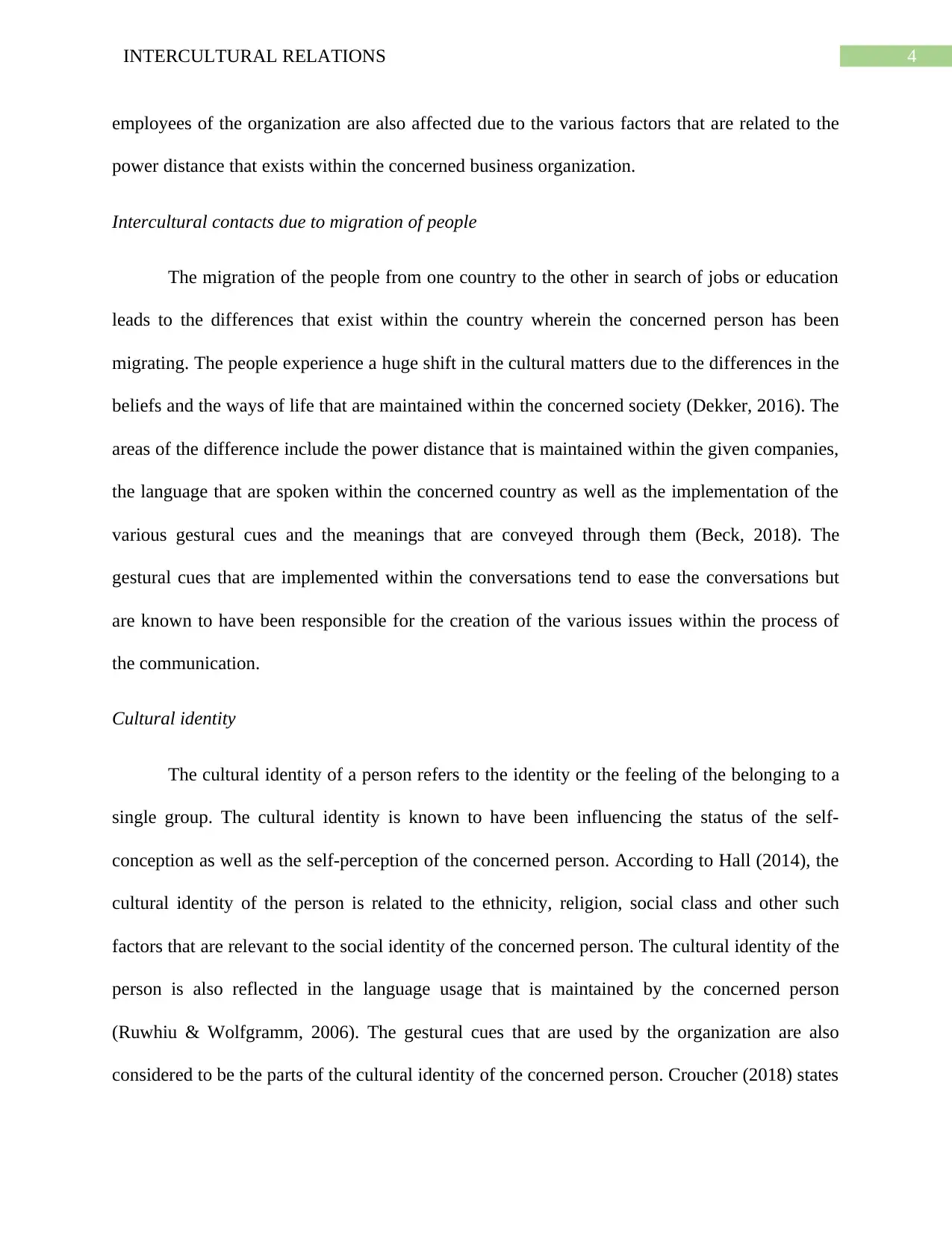
4INTERCULTURAL RELATIONS
employees of the organization are also affected due to the various factors that are related to the
power distance that exists within the concerned business organization.
Intercultural contacts due to migration of people
The migration of the people from one country to the other in search of jobs or education
leads to the differences that exist within the country wherein the concerned person has been
migrating. The people experience a huge shift in the cultural matters due to the differences in the
beliefs and the ways of life that are maintained within the concerned society (Dekker, 2016). The
areas of the difference include the power distance that is maintained within the given companies,
the language that are spoken within the concerned country as well as the implementation of the
various gestural cues and the meanings that are conveyed through them (Beck, 2018). The
gestural cues that are implemented within the conversations tend to ease the conversations but
are known to have been responsible for the creation of the various issues within the process of
the communication.
Cultural identity
The cultural identity of a person refers to the identity or the feeling of the belonging to a
single group. The cultural identity is known to have been influencing the status of the self-
conception as well as the self-perception of the concerned person. According to Hall (2014), the
cultural identity of the person is related to the ethnicity, religion, social class and other such
factors that are relevant to the social identity of the concerned person. The cultural identity of the
person is also reflected in the language usage that is maintained by the concerned person
(Ruwhiu & Wolfgramm, 2006). The gestural cues that are used by the organization are also
considered to be the parts of the cultural identity of the concerned person. Croucher (2018) states
employees of the organization are also affected due to the various factors that are related to the
power distance that exists within the concerned business organization.
Intercultural contacts due to migration of people
The migration of the people from one country to the other in search of jobs or education
leads to the differences that exist within the country wherein the concerned person has been
migrating. The people experience a huge shift in the cultural matters due to the differences in the
beliefs and the ways of life that are maintained within the concerned society (Dekker, 2016). The
areas of the difference include the power distance that is maintained within the given companies,
the language that are spoken within the concerned country as well as the implementation of the
various gestural cues and the meanings that are conveyed through them (Beck, 2018). The
gestural cues that are implemented within the conversations tend to ease the conversations but
are known to have been responsible for the creation of the various issues within the process of
the communication.
Cultural identity
The cultural identity of a person refers to the identity or the feeling of the belonging to a
single group. The cultural identity is known to have been influencing the status of the self-
conception as well as the self-perception of the concerned person. According to Hall (2014), the
cultural identity of the person is related to the ethnicity, religion, social class and other such
factors that are relevant to the social identity of the concerned person. The cultural identity of the
person is also reflected in the language usage that is maintained by the concerned person
(Ruwhiu & Wolfgramm, 2006). The gestural cues that are used by the organization are also
considered to be the parts of the cultural identity of the concerned person. Croucher (2018) states
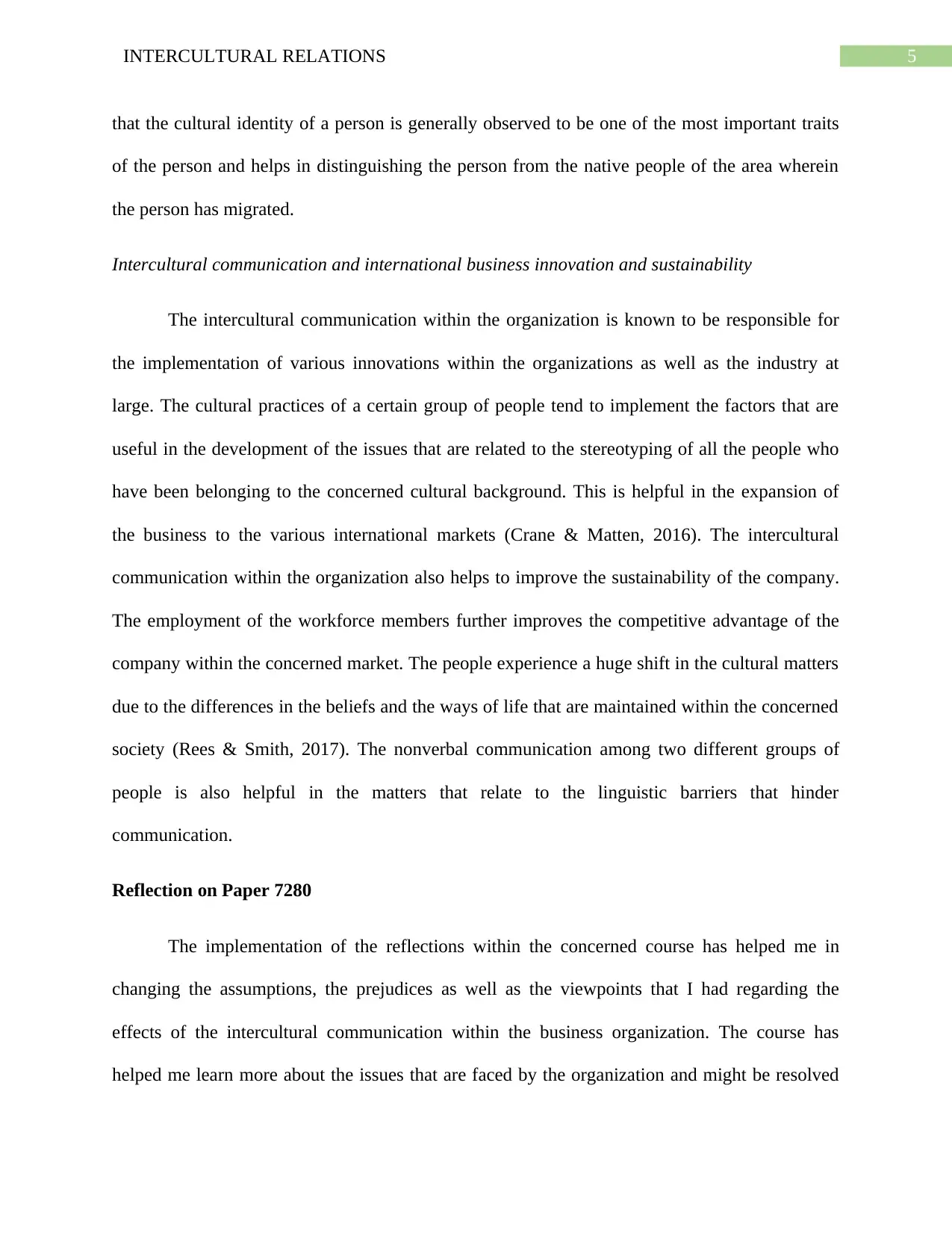
5INTERCULTURAL RELATIONS
that the cultural identity of a person is generally observed to be one of the most important traits
of the person and helps in distinguishing the person from the native people of the area wherein
the person has migrated.
Intercultural communication and international business innovation and sustainability
The intercultural communication within the organization is known to be responsible for
the implementation of various innovations within the organizations as well as the industry at
large. The cultural practices of a certain group of people tend to implement the factors that are
useful in the development of the issues that are related to the stereotyping of all the people who
have been belonging to the concerned cultural background. This is helpful in the expansion of
the business to the various international markets (Crane & Matten, 2016). The intercultural
communication within the organization also helps to improve the sustainability of the company.
The employment of the workforce members further improves the competitive advantage of the
company within the concerned market. The people experience a huge shift in the cultural matters
due to the differences in the beliefs and the ways of life that are maintained within the concerned
society (Rees & Smith, 2017). The nonverbal communication among two different groups of
people is also helpful in the matters that relate to the linguistic barriers that hinder
communication.
Reflection on Paper 7280
The implementation of the reflections within the concerned course has helped me in
changing the assumptions, the prejudices as well as the viewpoints that I had regarding the
effects of the intercultural communication within the business organization. The course has
helped me learn more about the issues that are faced by the organization and might be resolved
that the cultural identity of a person is generally observed to be one of the most important traits
of the person and helps in distinguishing the person from the native people of the area wherein
the person has migrated.
Intercultural communication and international business innovation and sustainability
The intercultural communication within the organization is known to be responsible for
the implementation of various innovations within the organizations as well as the industry at
large. The cultural practices of a certain group of people tend to implement the factors that are
useful in the development of the issues that are related to the stereotyping of all the people who
have been belonging to the concerned cultural background. This is helpful in the expansion of
the business to the various international markets (Crane & Matten, 2016). The intercultural
communication within the organization also helps to improve the sustainability of the company.
The employment of the workforce members further improves the competitive advantage of the
company within the concerned market. The people experience a huge shift in the cultural matters
due to the differences in the beliefs and the ways of life that are maintained within the concerned
society (Rees & Smith, 2017). The nonverbal communication among two different groups of
people is also helpful in the matters that relate to the linguistic barriers that hinder
communication.
Reflection on Paper 7280
The implementation of the reflections within the concerned course has helped me in
changing the assumptions, the prejudices as well as the viewpoints that I had regarding the
effects of the intercultural communication within the business organization. The course has
helped me learn more about the issues that are faced by the organization and might be resolved
⊘ This is a preview!⊘
Do you want full access?
Subscribe today to unlock all pages.

Trusted by 1+ million students worldwide
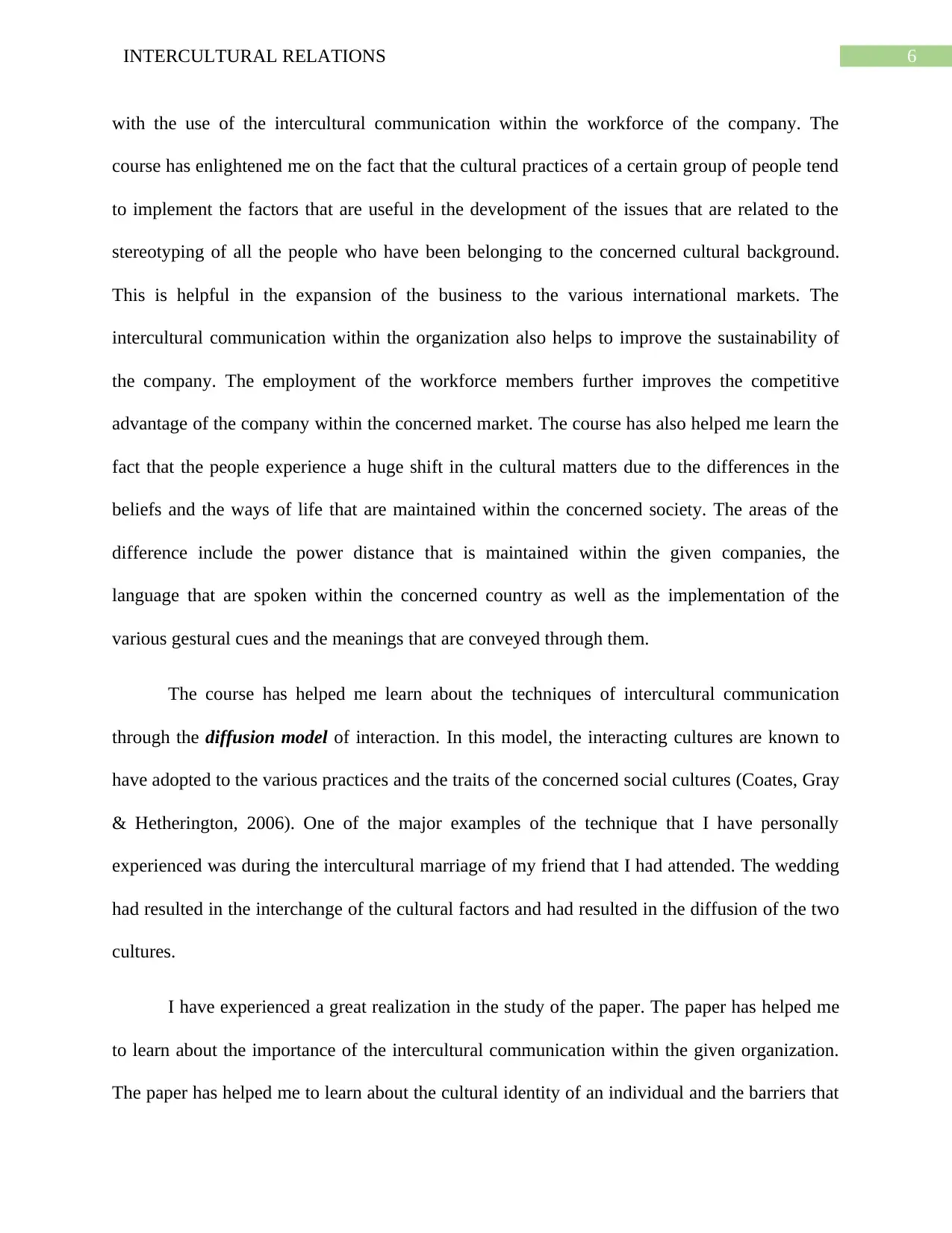
6INTERCULTURAL RELATIONS
with the use of the intercultural communication within the workforce of the company. The
course has enlightened me on the fact that the cultural practices of a certain group of people tend
to implement the factors that are useful in the development of the issues that are related to the
stereotyping of all the people who have been belonging to the concerned cultural background.
This is helpful in the expansion of the business to the various international markets. The
intercultural communication within the organization also helps to improve the sustainability of
the company. The employment of the workforce members further improves the competitive
advantage of the company within the concerned market. The course has also helped me learn the
fact that the people experience a huge shift in the cultural matters due to the differences in the
beliefs and the ways of life that are maintained within the concerned society. The areas of the
difference include the power distance that is maintained within the given companies, the
language that are spoken within the concerned country as well as the implementation of the
various gestural cues and the meanings that are conveyed through them.
The course has helped me learn about the techniques of intercultural communication
through the diffusion model of interaction. In this model, the interacting cultures are known to
have adopted to the various practices and the traits of the concerned social cultures (Coates, Gray
& Hetherington, 2006). One of the major examples of the technique that I have personally
experienced was during the intercultural marriage of my friend that I had attended. The wedding
had resulted in the interchange of the cultural factors and had resulted in the diffusion of the two
cultures.
I have experienced a great realization in the study of the paper. The paper has helped me
to learn about the importance of the intercultural communication within the given organization.
The paper has helped me to learn about the cultural identity of an individual and the barriers that
with the use of the intercultural communication within the workforce of the company. The
course has enlightened me on the fact that the cultural practices of a certain group of people tend
to implement the factors that are useful in the development of the issues that are related to the
stereotyping of all the people who have been belonging to the concerned cultural background.
This is helpful in the expansion of the business to the various international markets. The
intercultural communication within the organization also helps to improve the sustainability of
the company. The employment of the workforce members further improves the competitive
advantage of the company within the concerned market. The course has also helped me learn the
fact that the people experience a huge shift in the cultural matters due to the differences in the
beliefs and the ways of life that are maintained within the concerned society. The areas of the
difference include the power distance that is maintained within the given companies, the
language that are spoken within the concerned country as well as the implementation of the
various gestural cues and the meanings that are conveyed through them.
The course has helped me learn about the techniques of intercultural communication
through the diffusion model of interaction. In this model, the interacting cultures are known to
have adopted to the various practices and the traits of the concerned social cultures (Coates, Gray
& Hetherington, 2006). One of the major examples of the technique that I have personally
experienced was during the intercultural marriage of my friend that I had attended. The wedding
had resulted in the interchange of the cultural factors and had resulted in the diffusion of the two
cultures.
I have experienced a great realization in the study of the paper. The paper has helped me
to learn about the importance of the intercultural communication within the given organization.
The paper has helped me to learn about the cultural identity of an individual and the barriers that
Paraphrase This Document
Need a fresh take? Get an instant paraphrase of this document with our AI Paraphraser
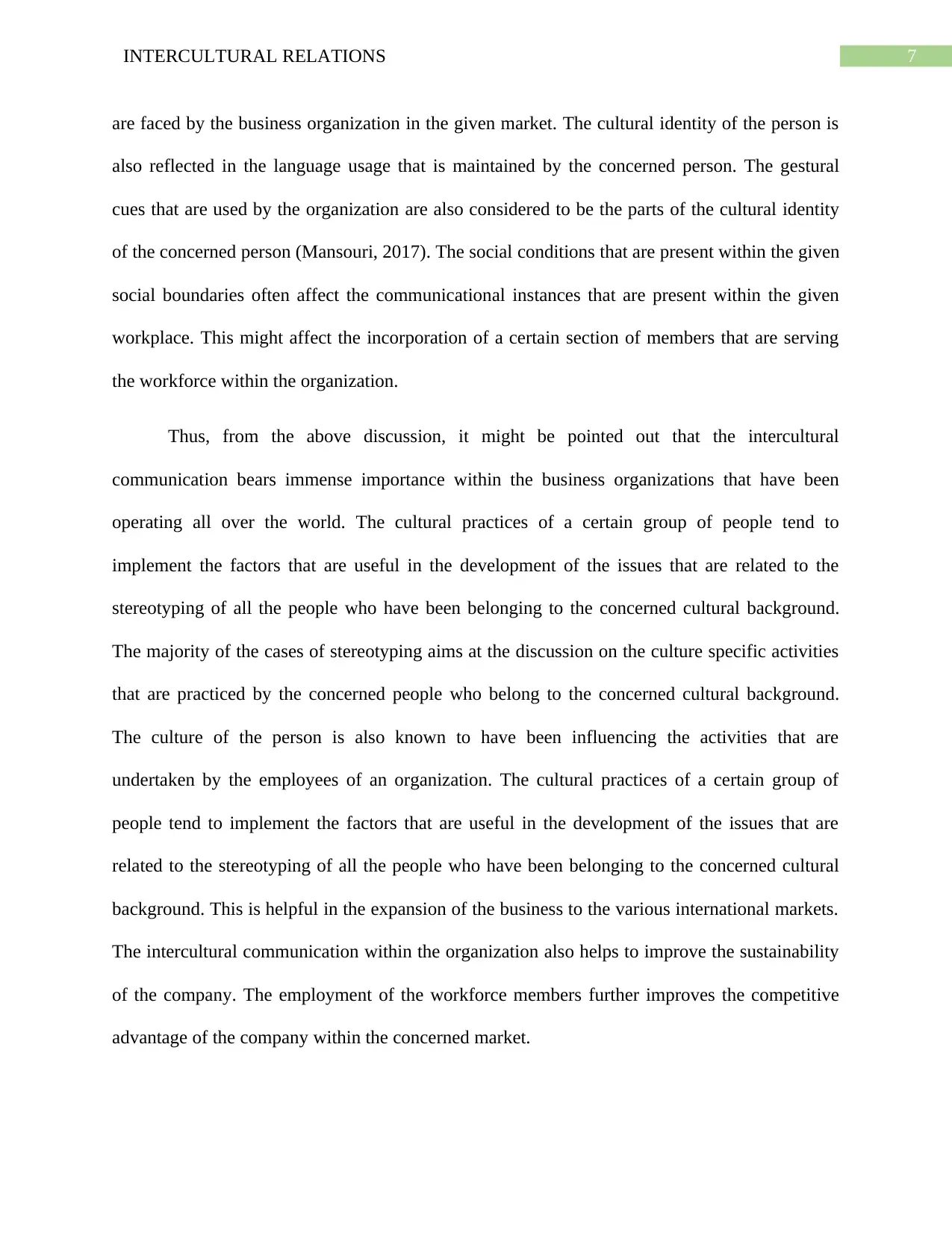
7INTERCULTURAL RELATIONS
are faced by the business organization in the given market. The cultural identity of the person is
also reflected in the language usage that is maintained by the concerned person. The gestural
cues that are used by the organization are also considered to be the parts of the cultural identity
of the concerned person (Mansouri, 2017). The social conditions that are present within the given
social boundaries often affect the communicational instances that are present within the given
workplace. This might affect the incorporation of a certain section of members that are serving
the workforce within the organization.
Thus, from the above discussion, it might be pointed out that the intercultural
communication bears immense importance within the business organizations that have been
operating all over the world. The cultural practices of a certain group of people tend to
implement the factors that are useful in the development of the issues that are related to the
stereotyping of all the people who have been belonging to the concerned cultural background.
The majority of the cases of stereotyping aims at the discussion on the culture specific activities
that are practiced by the concerned people who belong to the concerned cultural background.
The culture of the person is also known to have been influencing the activities that are
undertaken by the employees of an organization. The cultural practices of a certain group of
people tend to implement the factors that are useful in the development of the issues that are
related to the stereotyping of all the people who have been belonging to the concerned cultural
background. This is helpful in the expansion of the business to the various international markets.
The intercultural communication within the organization also helps to improve the sustainability
of the company. The employment of the workforce members further improves the competitive
advantage of the company within the concerned market.
are faced by the business organization in the given market. The cultural identity of the person is
also reflected in the language usage that is maintained by the concerned person. The gestural
cues that are used by the organization are also considered to be the parts of the cultural identity
of the concerned person (Mansouri, 2017). The social conditions that are present within the given
social boundaries often affect the communicational instances that are present within the given
workplace. This might affect the incorporation of a certain section of members that are serving
the workforce within the organization.
Thus, from the above discussion, it might be pointed out that the intercultural
communication bears immense importance within the business organizations that have been
operating all over the world. The cultural practices of a certain group of people tend to
implement the factors that are useful in the development of the issues that are related to the
stereotyping of all the people who have been belonging to the concerned cultural background.
The majority of the cases of stereotyping aims at the discussion on the culture specific activities
that are practiced by the concerned people who belong to the concerned cultural background.
The culture of the person is also known to have been influencing the activities that are
undertaken by the employees of an organization. The cultural practices of a certain group of
people tend to implement the factors that are useful in the development of the issues that are
related to the stereotyping of all the people who have been belonging to the concerned cultural
background. This is helpful in the expansion of the business to the various international markets.
The intercultural communication within the organization also helps to improve the sustainability
of the company. The employment of the workforce members further improves the competitive
advantage of the company within the concerned market.
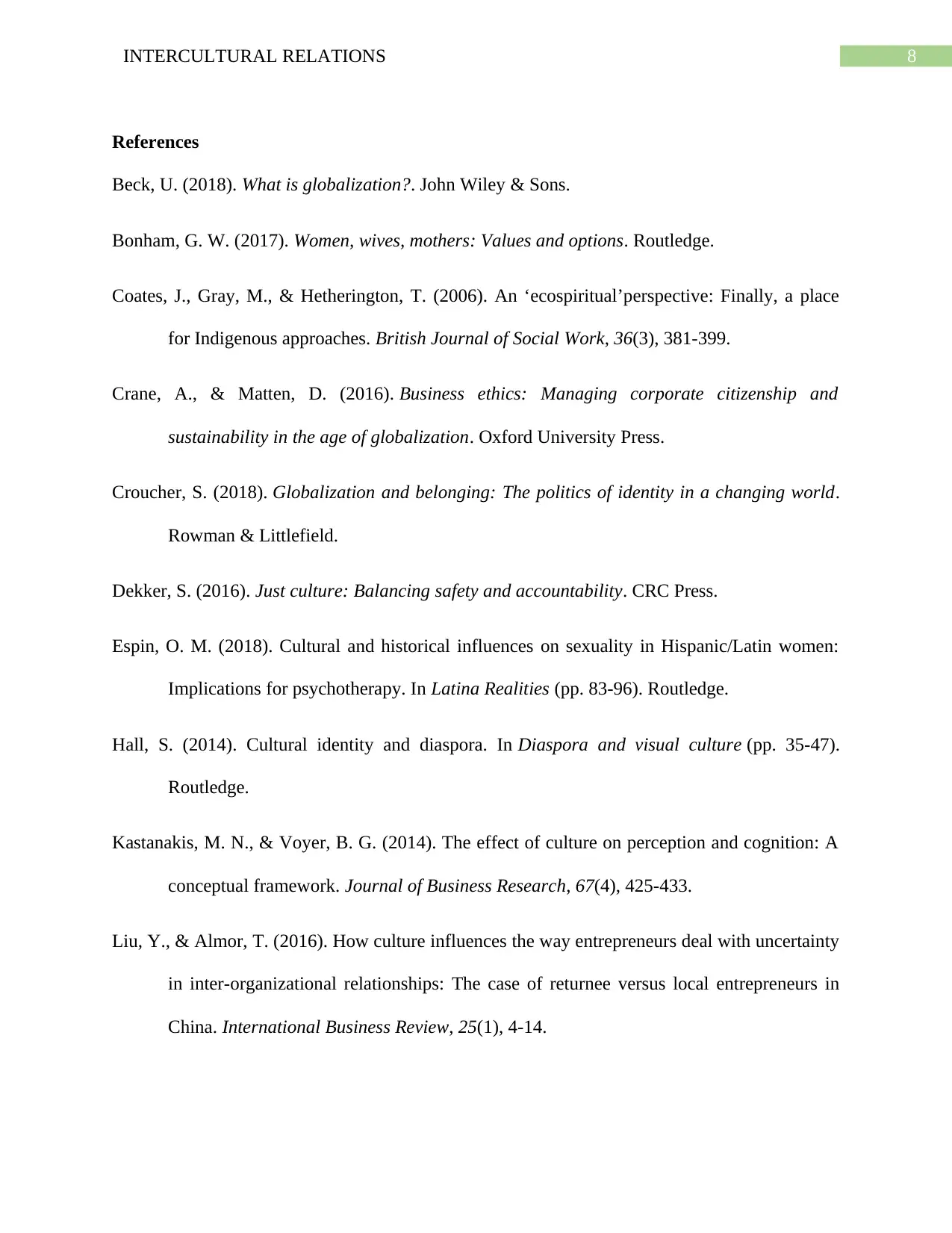
8INTERCULTURAL RELATIONS
References
Beck, U. (2018). What is globalization?. John Wiley & Sons.
Bonham, G. W. (2017). Women, wives, mothers: Values and options. Routledge.
Coates, J., Gray, M., & Hetherington, T. (2006). An ‘ecospiritual’perspective: Finally, a place
for Indigenous approaches. British Journal of Social Work, 36(3), 381-399.
Crane, A., & Matten, D. (2016). Business ethics: Managing corporate citizenship and
sustainability in the age of globalization. Oxford University Press.
Croucher, S. (2018). Globalization and belonging: The politics of identity in a changing world.
Rowman & Littlefield.
Dekker, S. (2016). Just culture: Balancing safety and accountability. CRC Press.
Espin, O. M. (2018). Cultural and historical influences on sexuality in Hispanic/Latin women:
Implications for psychotherapy. In Latina Realities (pp. 83-96). Routledge.
Hall, S. (2014). Cultural identity and diaspora. In Diaspora and visual culture (pp. 35-47).
Routledge.
Kastanakis, M. N., & Voyer, B. G. (2014). The effect of culture on perception and cognition: A
conceptual framework. Journal of Business Research, 67(4), 425-433.
Liu, Y., & Almor, T. (2016). How culture influences the way entrepreneurs deal with uncertainty
in inter-organizational relationships: The case of returnee versus local entrepreneurs in
China. International Business Review, 25(1), 4-14.
References
Beck, U. (2018). What is globalization?. John Wiley & Sons.
Bonham, G. W. (2017). Women, wives, mothers: Values and options. Routledge.
Coates, J., Gray, M., & Hetherington, T. (2006). An ‘ecospiritual’perspective: Finally, a place
for Indigenous approaches. British Journal of Social Work, 36(3), 381-399.
Crane, A., & Matten, D. (2016). Business ethics: Managing corporate citizenship and
sustainability in the age of globalization. Oxford University Press.
Croucher, S. (2018). Globalization and belonging: The politics of identity in a changing world.
Rowman & Littlefield.
Dekker, S. (2016). Just culture: Balancing safety and accountability. CRC Press.
Espin, O. M. (2018). Cultural and historical influences on sexuality in Hispanic/Latin women:
Implications for psychotherapy. In Latina Realities (pp. 83-96). Routledge.
Hall, S. (2014). Cultural identity and diaspora. In Diaspora and visual culture (pp. 35-47).
Routledge.
Kastanakis, M. N., & Voyer, B. G. (2014). The effect of culture on perception and cognition: A
conceptual framework. Journal of Business Research, 67(4), 425-433.
Liu, Y., & Almor, T. (2016). How culture influences the way entrepreneurs deal with uncertainty
in inter-organizational relationships: The case of returnee versus local entrepreneurs in
China. International Business Review, 25(1), 4-14.
⊘ This is a preview!⊘
Do you want full access?
Subscribe today to unlock all pages.

Trusted by 1+ million students worldwide
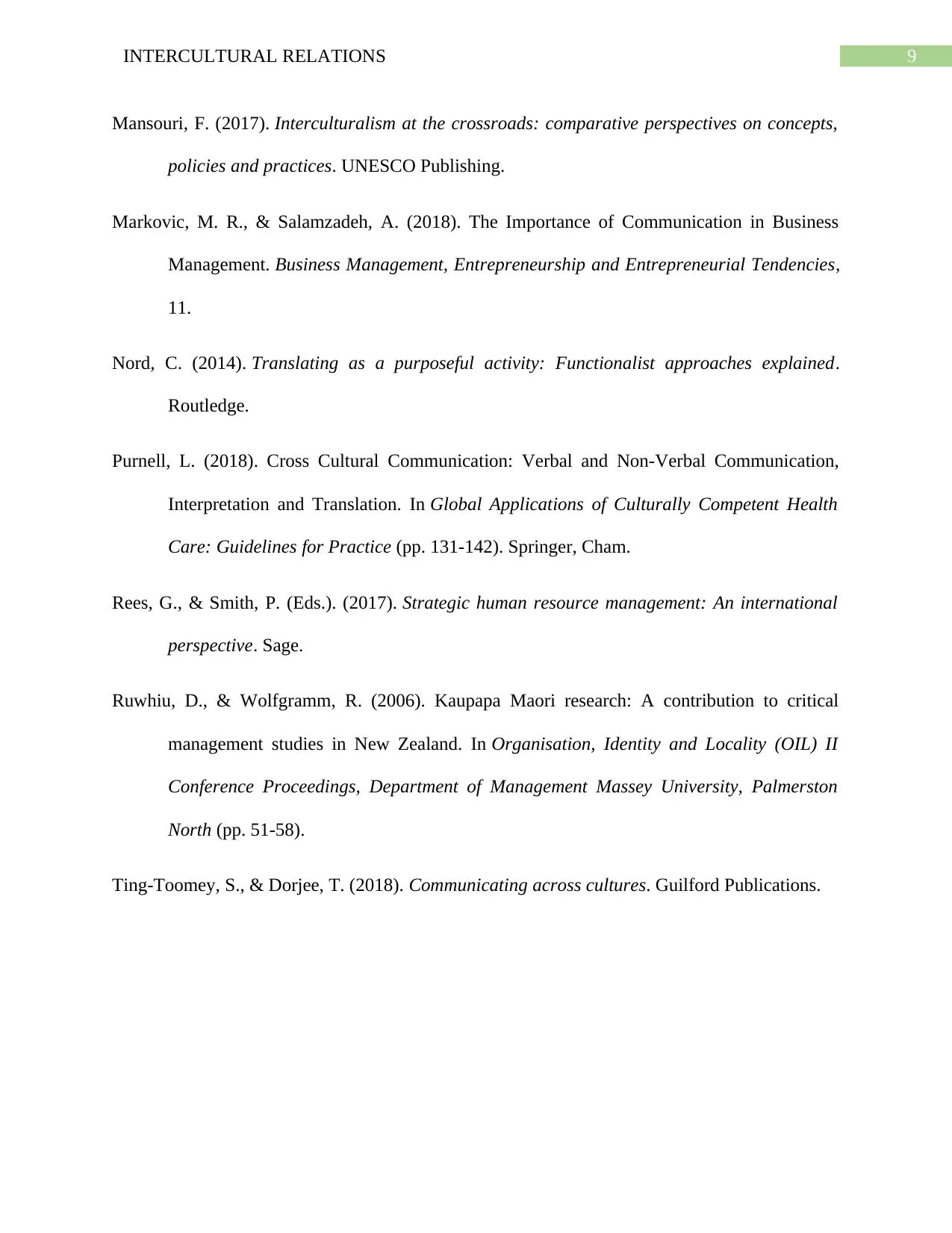
9INTERCULTURAL RELATIONS
Mansouri, F. (2017). Interculturalism at the crossroads: comparative perspectives on concepts,
policies and practices. UNESCO Publishing.
Markovic, M. R., & Salamzadeh, A. (2018). The Importance of Communication in Business
Management. Business Management, Entrepreneurship and Entrepreneurial Tendencies,
11.
Nord, C. (2014). Translating as a purposeful activity: Functionalist approaches explained.
Routledge.
Purnell, L. (2018). Cross Cultural Communication: Verbal and Non-Verbal Communication,
Interpretation and Translation. In Global Applications of Culturally Competent Health
Care: Guidelines for Practice (pp. 131-142). Springer, Cham.
Rees, G., & Smith, P. (Eds.). (2017). Strategic human resource management: An international
perspective. Sage.
Ruwhiu, D., & Wolfgramm, R. (2006). Kaupapa Maori research: A contribution to critical
management studies in New Zealand. In Organisation, Identity and Locality (OIL) II
Conference Proceedings, Department of Management Massey University, Palmerston
North (pp. 51-58).
Ting-Toomey, S., & Dorjee, T. (2018). Communicating across cultures. Guilford Publications.
Mansouri, F. (2017). Interculturalism at the crossroads: comparative perspectives on concepts,
policies and practices. UNESCO Publishing.
Markovic, M. R., & Salamzadeh, A. (2018). The Importance of Communication in Business
Management. Business Management, Entrepreneurship and Entrepreneurial Tendencies,
11.
Nord, C. (2014). Translating as a purposeful activity: Functionalist approaches explained.
Routledge.
Purnell, L. (2018). Cross Cultural Communication: Verbal and Non-Verbal Communication,
Interpretation and Translation. In Global Applications of Culturally Competent Health
Care: Guidelines for Practice (pp. 131-142). Springer, Cham.
Rees, G., & Smith, P. (Eds.). (2017). Strategic human resource management: An international
perspective. Sage.
Ruwhiu, D., & Wolfgramm, R. (2006). Kaupapa Maori research: A contribution to critical
management studies in New Zealand. In Organisation, Identity and Locality (OIL) II
Conference Proceedings, Department of Management Massey University, Palmerston
North (pp. 51-58).
Ting-Toomey, S., & Dorjee, T. (2018). Communicating across cultures. Guilford Publications.
1 out of 10
Related Documents
Your All-in-One AI-Powered Toolkit for Academic Success.
+13062052269
info@desklib.com
Available 24*7 on WhatsApp / Email
![[object Object]](/_next/static/media/star-bottom.7253800d.svg)
Unlock your academic potential
Copyright © 2020–2025 A2Z Services. All Rights Reserved. Developed and managed by ZUCOL.




